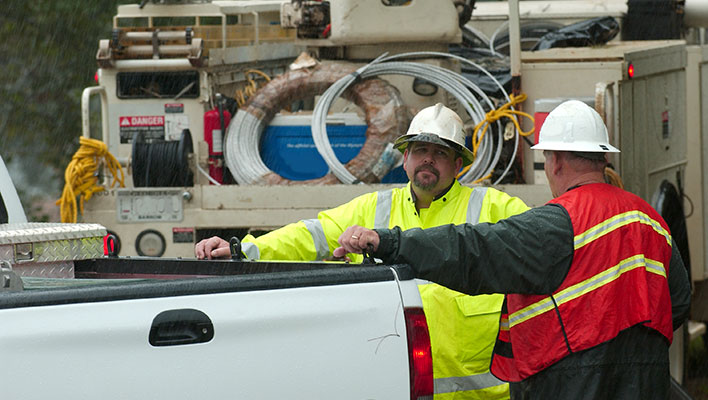Technological advancements over the last decade have introduced exciting opportunities for utilities of all types, including smart phones, tablets, and 5G cellular networks. Such technology is ideally suited for empowering field teams with mobile workforce management capabilities to orchestrate crews, work, and assets, giving rise to software and connectivity solutions to manage these pieces.
Utilities, cooperatives, and municipal providers looking to adopt mobile workforce management (MWM) solutions are presented with a complex array of options and terminology. This guide aims to clarify key concepts and provide the top 10 things you should consider when selecting MWM solutions.
Mobile Workforce Management Defined
MWM is a category of enterprise software that is used to manage employees and contractors working in the field supporting a wide variety of utility and service types. These include management of electrical grids, natural gas, or water distribution systems, internet, and telecommunication networks. MWM involves procuring and deploying mobile devices and apps into the field in order to manage work assignments, improve crew performance, track crew time, and provide 2-way communication between the field and back office for routine (blue sky) and unplanned (dark sky) work.
Once deployed, a mobile workforce management solutions should support key business drivers, including safety, system reliability, and cost containment.
Not to Be Confused with Mobile Workforce Management
Use the following definitions to navigate technologies related to MWM that either complement or are encompassed by mobile workforce management.
Field Service Management
FSM solutions extend an organization’s customer relationship management (CRM) platform with capabilities focused on managing end-user/customer experience, from capturing service requests to communicating with customers.
Managed Mobility Services
An important component of a MWM strategy, MMS refers to the information technology and process used to procure, deploy, and manage smart phones, tablets, and cellular services.
Work Management System
WMS software enables utilities and other service providers to plan jobs, manage rosters, and assign workorders to field teams primarily for routine work.
Outage Management System
Intended to meet the complexities of service outage from storms, OMS software generates predictive models for estimating service area impact and tools to remotely monitor and reroute service.
Computerized Maintenance Management System
CMMS is a specific category of software for centralizing digital maintenance records, managing maintenance operations, and optimizing physical asset utilization, such as parts, tools, and equipment.
The Opportunity for Mobile Workers
There are more than 220,000 field workers in the utilities sector alone with 57% of the US mobile workforce comprised of frontline workers. However, only 49% of frontline workers are currently supported by mobile technology, a tremendous opportunity for service providers to further advance safety, improve reliability, and reduce field costs.
Essential Mobile Workforce Management Checklist
Set your organization up for successful MWM by identifying what approach, technology, and value-adding capabilities make solutions standout. Here are the 10 most important things to consider when developing your mobile workforce management strategy and evaluating MWM software.
#1 Utilities-Specific Solution
Look for solutions that are purpose-built for the unique mobile workforce management challenges of critical infrastructure based on real-world utility operations experience.
#2 Clear Focus on Operations
Solutions should focus solely on optimizing operations for utilities and not be a subcomponent of an enterprise resource planning (ERP) framework that prioritizes a “one size fits all” approach across many service sectors and industries.
#3 Hybrid Workforce Management
Solutions should equip employees and large numbers of contractors with secure access to the same mobile workforce management tools, system maps, and street level view of crews, work, and assets.
#4 Situational Awareness
Look for MWM solutions that offer a single pane of glass to manage people, work, and assets across routine short cycle work, long cycle construction, and storm restoration.
#5 Ease of Use
The most effective MWM solutions are easy for field workers to learn and use, offer features designed by crews for crews like hands free notetaking, and increase user adoption with an intuitive user interface.
#6 Software Ecosystem Integration
Look for solutions offering pre-built data connectors to eliminate data silos and app overload by bringing WMS, OMS, CMMS, geospatial, and asset management together in a single platform.
#7 Syncing the Field and Back Office
Solutions that integrate data silos should also synchronize field data directly with systems of record through bidirectional data connections, including GIS and work management systems.
#8 Seamless Experience Across Work Types
Identify mobile workforce management solutions that enable field workers to seamlessly switch between planned and unplanned work, routine maintenance to storm restoration in a single, fully integrated MWM platform.
#9 Measurable Business Value
Mobile workforce management solutions should be able to demonstrate measurable value, from reducing safety incidents and SAIDI/CAIDI to accelerated storm cost recovery and lower OpEx.
#10 Customer-Led Innovation
Finally, seek out software providers who are willing to partner with your team and provide direct input into product roadmaps and future innovation that benefits your organization.




